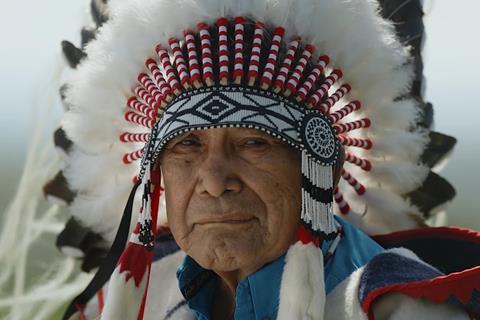Breezy, earnest exploration of the startling impact Indigenous culture has had on the modern world

Dirs: Neil Diamond, Catherine Bainbridge. Canada. 2024. 104mins
Following up their 2009 Peabody Award-winning documentary Reel Injun, which studied Hollywood’s often bigoted portrayal of Native Americans, Cree filmmaker Neil Diamond and co-director Catherine Bainbridge now undertake a breezy but earnest exploration of the myriad ways Indigenous societies have shaped the modern world, from contemporary fashion to democracy itself.
A feel-good vibe that seeks to inform rather than scold or shame
Premiering at Hot Docs, this Indigenous Canadian production is a commendable educational tool that could be shown in classrooms as well as further documentary festivals. Diamond (not to be confused with the American singer-songwriter) serves as Red Fever’s on-screen guide, and his charming presence adds to the film’s appeal. At a time when Killers Of The Flower Moon has helped shed light on the cruelty Native Americans faced in the 20th century, Red Fever should be warmly embraced.
Early on in Red Fever, Diamond ponders the world’s endless interest in Indigenous culture, despite its inhabitants’ consistent attempts to destroy and dehumanise Native Peoples. “There is a deeper story about why the world is fascinated with us,” he says in voiceover, “and how profoundly we’ve influenced them.” To explore this, the film is divided into four sections, each of them concentrating on one aspect of Indigenous influence: fashion, sports, politics and the planet.
Travelling from Canada to the US and Europe, Diamond interviews scholars, writers and artists, highlighting the underappreciated impact that Indigenous Peoples have had on those who conquered their lands. Whether through the name of a baseball team or the blatant appropriation of Indigenous style on the catwalk, these influences are everywhere – rarely with a thought for the Native cultures that spawned them.
As an expression of Indigenous pride, Red Fever radiates a feel-good vibe that seeks to inform rather than scold or shame. Diamond often sidesteps his understandable anger, although the film is clear-eyed about the evil of appropriation — illustrating, for instance, how clothing designers’ scavenging of Native fashions is far more insidious than simple creative theft. As Indigenous designers explain, this ‘borrowing’ reinforces the notion that Native cultures can simply be plundered without consequence, further minimising people who have already been systematically marginalised by Europeans who colonised North America centuries earlier.
The documentary can occasionally feel unfocused, but Diamond and Bainbridge’s digressions have merit. During a discussion of Jim Thorpe, an extraordinary Native American athlete of the 20th century, Red Fever also recognises the Carlisle Indian Industrial School, the boarding school Thorpe attended whose champion American Football team invented many of the innovative trick plays that are now commonplace in the sport.
Tellingly, the film prefers to dwell on Indigenous athletic achievements rather than spend too much time on the gross stereotypes perpetuated by sports teams that have caricatured Native American iconography for their mascots and logos. (That said, Diamond’s silent disdain while being surrounded by white fans of the Kansas City Chiefs, who crudely imitate Indigenous rituals when their team is doing well, speaks volumes.)
Perhaps most fascinating is Red Fever’s section on politics, which investigates how both the Enlightenment and the forming of the United States drew inspiration from Indigenous Peoples’ harmonious governments. As one talking head notes, there is a bitter irony to the fact that, when Europeans colonised North America, their governments were far less advanced than those of the people they viewed as unsophisticated savages. This arrogance serves as a sobering theme throughout Red Fever, which observes the constant tendency of outsiders to dismiss Indigenous life while stealing or corrupting the culture’s foundational aspects.
But the filmmakers, embodied by Diamond’s friendly demeanour, choose resilience over bitterness. And the documentary does show encouraging signs of progress — such as fashion houses now collaborating with Indigenous artists when dreaming up their latest clothing lines — while emphasising just how present Native Peoples are in today’s society. In its humble way, Red Fever is an act of defiance, a statement of visibility from cultures that were threatened with erasure but are growing more powerful in reclaiming some of what has been taken from them.
Production company: Rezolution Pictures
International sales: Les Films du 3 Mars, distribution@f3m.ca
Producers: Lisa M. Roth, Catherine Bainbridge
Editing: Rebecca Lessard
Music: Jesse Zubot, Pura Fe






![The Brightest SunScreen[Courtesy HKIFF]](https://d1nslcd7m2225b.cloudfront.net/Pictures/274x183/3/5/0/1448350_thebrightestsunscreencourtesyhkiff_312678.jpg)















![The Brightest SunScreen[Courtesy HKIFF]](https://d1nslcd7m2225b.cloudfront.net/Pictures/100x67/3/5/0/1448350_thebrightestsunscreencourtesyhkiff_312678.jpg)

